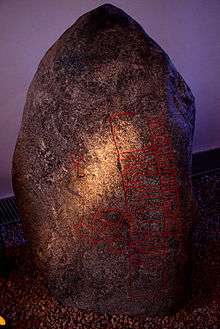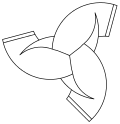Snoldelev Stone
The Snoldelev Stone, listed as DR 248 in the Rundata catalog, is a 9th-century runestone that was originally located at Snoldelev, Ramsø, Denmark.
| Snoldelev Stone | |
|---|---|
 | |
| Created | Viking Age |
| Discovered | Snoldelev, Ramsø, Denmark |
| Present location | National Museum of Denmark in Copenhagen |
| Rundata ID | DR 248 |
| Runemaster | unknown |
| Text – Native | |
| Gunwalds sten, sonaʀ Roalds, þulaʀ a Salhøgum. | |
| Translation | |
| Gunnvaldr's stone, Hróaldr's son, reciter of Salhaugar | |
Description
The Snoldelev Stone, which is 1.25 meters in height, is decorated with a design of three drinking horns interlocking as incomplete Borromean rings (similar to the Diane de Poitiers three crescents emblem). The stone was first noted in 1810, and was turned over to the national Antiquities Commission in 1811.[1] The runestone is now housed at the National Museum of Denmark in Copenhagen, Denmark.
The inscription on the Snoldelev Stone shows an early version of the Younger Futhark. Like the late Elder Futhark Björketorp Runestone, it uses an a-rune ![]()
![]()
![]()
The inscription states that Gunnvaldr is a Þulʀ, which signifies some office or rank, perhaps a priest or a skald, compare Old Norse þula meaning "litany." It is related to the later Norse Þulr, a position described as being a wise man or sage associated with Scandinavian chieftains and royalty. The translation offered by the Rundata project suggests reciter. The location Salhaugar in the text has been identified as referring to the modern town Salløv, which was in the vicinity of the original site of the runestone.[3] The literal translation of the Old Norse Salhøgum combines sal "hall" with hörgar "mounds," to form "on the hall mounds," suggesting a place with a room where official meetings took place.[4]
Inscription
Runes
- ᚴᚢᚾ᛫ᚢᚼᛚᛏᛋ ᛐᚼᛁᚾ ᛋᚢᚾᛅᛦ
- ᚱᚢᚺᛅᛚᛏᛋ ᛫ ᚦᚢᛚᛅᛦ ᛫ ᚨ ᛋᛅᛚᚺᛅᚢᚴᚢ
Transliteration of the runes into Latin characters
- kun'uAlts| |stAin ' sunaʀ ' ruHalts ' þulaʀ ' o salHauku(m)[5]
Transcription into Old Norse
- Gunwalds sten, sonaʀ Roalds, þulaʀ a Salhøgum.[5]
Translation in English
- Gunnvaldr's stone, Hróaldr's son, reciter of Salhaugar.[5]
Gallery
 Detail of swastika found on the stone
Detail of swastika found on the stone- Detail of the interlaced horns
 Snoldelev interlaced horns design (illustration)
Snoldelev interlaced horns design (illustration)
See also
References
- Nielsen, Karl Martin (1974). "Raskstydning af Snoldelev-Indskriften" (PDF). Danske Studier (in Danish). Copenhagen: Akademisk Forlag: 132–135. ISSN 0106-4525. Retrieved 8 July 2011.
- Birkmann, Thomas (1995). "Die Enstehung des Jüngeren Fuþark". Von Agedal Bis Malt. Berlin: Walter de Gruyter. pp. 204–205. ISBN 3-11-014510-3.
- Peterson, Lena (2002). Nordisk runnamslexikon Archived 2011-02-25 at the Wayback Machine. Swedish Institute for Linguistics and Heritage (Institutet för språk och folkminnen).
- Sundqvist, Olof (2009). "The Hanging, the Nine Nights, and the "Precious Knowledge"". In Heizmann, Wilhelm; Beck, Heinrich (eds.). Analecta Septentrionalia. Berlin: Walter de Gruyter. pp. 660–661. ISBN 978-3-11-021869-5.
- Project Samnordisk Runtextdatabas Svensk - Rundata entry for DR 248.
External links
- Inscriptions from the second period (Viking period), 750-1025, presentation by Moltke